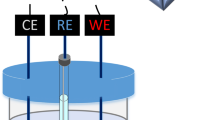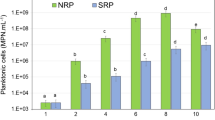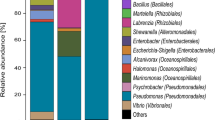Summary
The corrosion of AISI C1020 carbon steel in an anoxic, marine, sulphide-containing environment was examined as a function of bacterial physiology and consortial complexity. The carbon steel was exposed to three organism;Eubacterium limosum, Desulfovibrio sp. andDesulfobacter sp. which were provided with H2/CO2, butanol, glucose, and acetate as carbon and electron sources. A consortium of these bacteria utilizing hydrogen gave rise to relatively high corrosion rates (5.7×10−4 mhos cm−2) with respect to corrosion resulting from bacteria supplied with organic electron sources (0.6–1.6×10−4 mhos cm−2). Disproportionation of electrons between sulphate reduction and fermentation had a significant effect on the corrosion rate in the case ofDesulfovibrio. Surface examination using scanning electron microscopy coupled with electrochemical impedance spectroscopy supported the hypothesis that the corrosion rate was controlled by the relative intactness of a ferrous sulphide film in which the bacteria were embedded.
Similar content being viewed by others
References
Dexter, S. 1986. Biologically Induced Corrosion. National Association for Corrosion Engineers (NACE), Houston, TX.
Phelps, T.J., R.M. Schram, D. Ringleberg, N.J.E. Dowling and D.C. White. 1992. Anaerobic microbial activities including hydrogen-mediated acetogenesis within natural gas transmission lines. Biofouling, in press.
Dias, O.C. and M.C. Bromel. 1990. Microbially induced organic acid underdeposit attack in a gas pipeline. Mats. Perf., April, 53–56.
Dowling, N.J.E., Nichols, P.D. and D.C. White. 1988. Phospholipid fatty acid and infra-red spectroscopic analysis of a sulphate-reducing consortium. FEMS Microbiol. Ecol. 53: 325–334.
Widdel, F. and N. Pfennig. 1984. Dissimilatory sulphate or sulphur-reducing bacteria. In: Bergey's Manual for Systematic Bacteriology, Vol. 1 (Krieg, N., ed.), Williams and Wilkins, Baltimore.
Dowling, N.J.E., J. Guezennec, M.L. Lemoine, A. Tunlid and D.C. White. 1988. Analysis of carbon steels affected by bacteria using electrochemical impedance and direct current techniques. Corrosion (NACE) 44 (12): 869–874.
MacDonald, J.R. 1987. Impedance Spectroscopy. Wiley-Intersience, New York.
MacDonald, D.D. 1987. Theoretical analysis of the electrochemical impedance. Article No. 479, Corrosion 87. NACE, Houston, TX.
Tabatabai, M.A. 1974. Determination of sulphate in water samples. Sulphur Inst. J. 10: 11–13.
Bonnel, A., F. Dabosi, C. Deslouis and M., Duprat. 1983. Corrosion study of a carbon steel in neutral chloride solutions by impedance techniques. J. Electrochem. Soc. 130(4): 753–766.
McNeil, M.B. and B.J. Little. 1990. Technical note: Mackinawite formation during microbial corrosion. Corrosion 46 (7): 599–600.
Hamilton, W.A. 1985. Sulphate=reducing bacteria and anaerobic corrosion. Annu. Rev. Microbiol. 39: 195.
Cord-Ruwisch, R. and F. Widdel. 1986. Corroding iron as a hydrogen source for sulphate-reduction in growing cultures of sulphate-reducing bacteria. Appl. Microbiol. Biotechnol. 25: 169–174.
Iverson, W.P. 1984. Mechanism of anaerobic corrosion of steel by sulphate-reducing bacteria. Mats. Perf. 23: 28–30.
Booth, G.H. and A.K. Tiller. 1968. Cathodic characteristics of mild steel in suspensions of sulphate-reducing bacteria. Corrosion Sci. 3: 583–600.
Von Wolzogen Kuhr, C.A.V. and L.S. Van der Vlugt. 1934. Water (The Hague) 18 (16): 147.
Thauer, R.K., K. Jungermann and K. Decker. 1977. Energy conservation in chemotrophic anaerobic bacteria. Bacteriol. Rev. 41: 100–180.
Moller, D., R. Schauder, G. Fuchs and R.K. Thauer. 1987. Acetate oxidation to CO2 via a citric acid cycle involving an ATP-citrate lyase: a mechanism for the synthesis of ATP via substrate-level phosphorylization inDesulfobacter, postgatei growing on acetate and sulfate. Arch. Microbiol. 148: 202–207.
Robinson, J.A. and J.M. Tiedje. 1984. Competition between sulfate-reducing and methanogenic bacteria for H2 under resting and growing conditions. Arch. Microbiol. 137: 26–32.
Genther, B.R.S. and M.P. Bryant. 1987. Additional characteristics of one-carbon-compound utilization byEubacterium limosum andAcetobacterium woodii. Appl. Environ. Microbiol. 53: 471–476.
Cord-Ruwisch, R., H.-J. Seitz and R. Conrad. 1988. The capacity of hydrogenotrophic anaerobic bacteria to compete for traces of hydrogen depends on the redox potential of the terminal electron acceptor. Arch. Microbiol. 149: 350–357.
Gottschalk, G. 1986. Bacterial Metabolism. 2nd Edn. Springer-Verlag, New York.
Author information
Authors and Affiliations
Rights and permissions
About this article
Cite this article
Dowling, N.J.E., Brooks, S.A., Phelps, T.J. et al. Effects of selection and fate of substrates supplied to anaerobic bacteria involved in the corrosion of pipe-line steel. Journal of Industrial Microbiology 10, 207–215 (1992). https://doi.org/10.1007/BF01569768
Received:
Revised:
Accepted:
Issue Date:
DOI: https://doi.org/10.1007/BF01569768




